ConstructConnect Takeoff includes numerous Result formulas for each Takeoff Item Type (Linear, Area, Count, Attachment). If you cannot find one that suits your needs, you can create a Custom Formula.
There are numerous "Variables" you can use in your formulas, please see Related Articles for a list of all available variables you can use in Custom Formulas.
Remember, depending on how you measure something (as a Linear, Area, or Count or all three...), you may need to create similar Custom Formulas to calculate the same Material for each Type of Takeoff Item.
Creating Custom Formulas for Area Takeoff Items
In this example, we are going to consider the plaster (surface) and gunite (volume) materials for a pool. We are assuming an average sidewall height of 4'6" and a thickness of 4".
We use an Area Takeoff Item to account for the bottom of the pool (SF). To account for the surface of walls, we could take them off using a Linear Takeoff Item, but then we would have to add the two Takeoff Items Results together manually. We also need to consider the volume (which is just surface area times the Takeoff Item's Thickness (4"), but that would create two additional Results we would have to add together. We want all these measurements associated with one Takeoff Item and taken off as quickly as possible.
We create a custom formula that takes that existing Area result (SF), and adds the perimeter measurement of the Area we took off (which is an existing System Result/Formula) multiplied by the Height we specify in our Formula (4.5 feet). This gets our overall square footage (plaster). To calculate the Volume, we simply multiple that Custom Formula by 4 inches (or more correctly, 1/8 yard because concrete is ordered by the cubic yard, not the cubic inch).
In the Takeoff Item's Results tab, click the  button at the bottom of the Results list, this opens up the Area Formulas window.
button at the bottom of the Results list, this opens up the Area Formulas window.
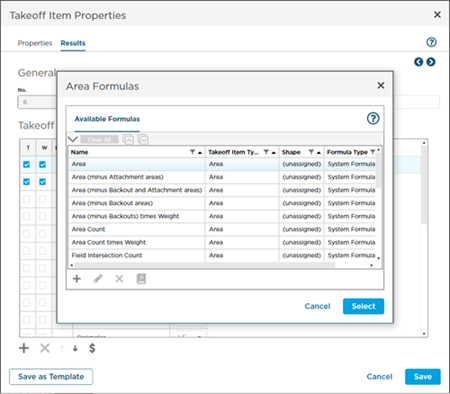
Click the  button in the Area Formulas list to add a new, Custom Formula using the Formula Editor (introduced in the previous articles).
button in the Area Formulas list to add a new, Custom Formula using the Formula Editor (introduced in the previous articles).
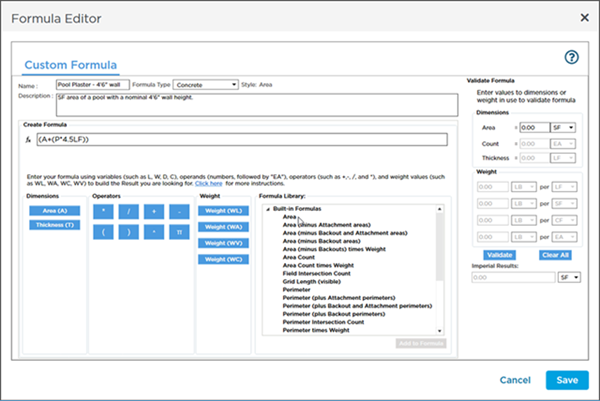
Our formula starts by taking the Area's surface area (A) and adding it to the result of the perimeter (P) multiplied by the Height we specify (4.5LF). This gives us an overall SF total include the bottom of the pool (the "A" in our Formula) and the walls (the "P*4.5LF" in our Formula).
When adding and multiplying, it is important to pay close attention to the Unit of Measure for a Result or dimension. If we had left off the "LF" from "4.5" in our Formula, we would have been trying to add SF (A) to a LF (P*4.5) - the program would have generated an error about this...

Be careful with operators also. In our formula, we want to add the two area measurements (SF) together, if we had accidentally used a calculation symbol instead of the plus sign, we would get a incorrect Result (grossly inflated) and incorrect UOM (CF instead of SF).
Because we are using perimeter and that value can only be determined by drawing takeoff, we cannot validate the formula within the Formula Editor.
Save the formula and add it to the Takeoff Item's Results.
Return to the Takeoff Tab and draw a rectangle 10' x 20'.
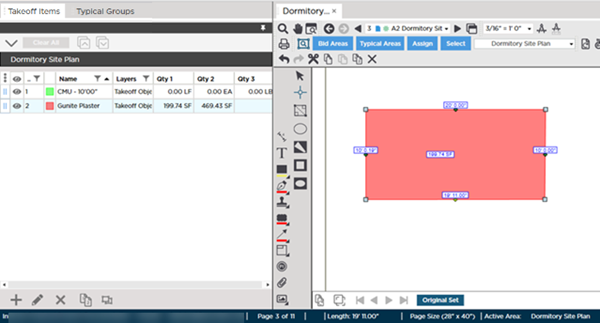
Our Square footage result (just the visible plane) is approximately 200SF (we are off, fractionally on one of the segments). Our perimeter value is 60LF (20+10+20+10). Based on our formula, we are going to take our area calculation (200SF) and add it to the product of our perimeter (60LF) multiplied by 4.5LF (height) which comes to approximately 270SF, for a total of about 470SF. If we wanted to be more precise, we could adjust that bottom segment of our takeoff object - as you can see, when you multiple takeoff values, small discrepancies can add up. But for our example, we will consider our results "close enough" for an estimate.
Next, we add a formula to take the Results of the Custom Formula we just created and multiple that by 4" to account for the volume of gunite we require.
Open the Takeoff Item's Results tab, again, and follow the steps above to add another Custom Formula.
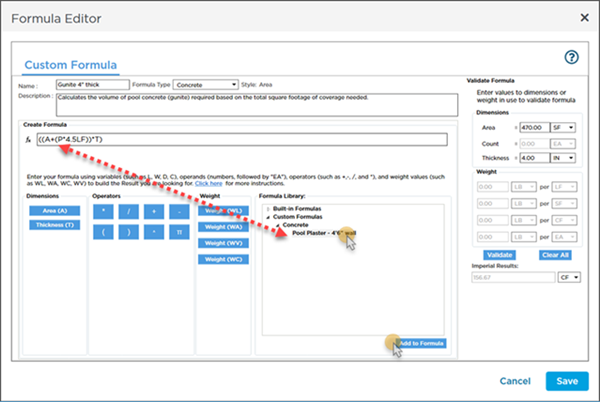
In the Formula Library, click on the Custom Formula we just created above and select Add to Formula.
Then, multiply that by the Takeoff Item's Thickness value (T). We can validate this in the right side panel because we are basing the calculations off a SF result, not necessarily the perimeter value used to get to that surface Result.
Add this Custom Formula to the Takeoff Item's Results and return to the Takeoff Tab.
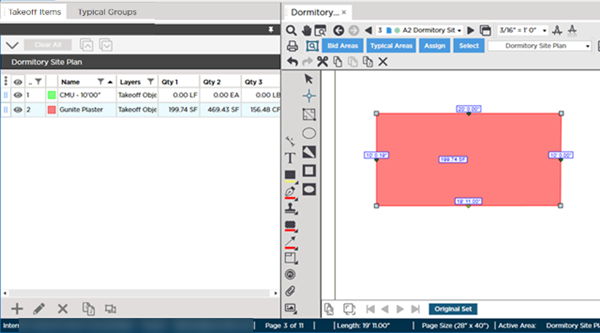
The two custom formulas we created can now provide us a way of measuring a three dimensional object quickly and easily. You can create several Formulas to accommodate different nominal heights.
These Results work for rectangles, ovals, even complex polygon Area takeoffs. Just keep in mind, you have to figure out the average sidewall Height for the Area.
If you wanted, you could use the Volume Custom Formula you just created to calculate weight, see previous article for instructions on adding a Weight to a Custom Formula.
Reminder, depending on how you measure something (as a Linear, Area, or Count or all three...), you may need to create similar Custom Formulas to calculate the same Material for each Type of Takeoff Item.

 button at the bottom of the Results list, this opens up the Area Formulas window.
button at the bottom of the Results list, this opens up the Area Formulas window.





 Custom Formula Example - Linears
Custom Formula Example - Linears